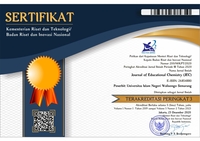Analysis High Order Level Thinking Skills of High School Students in Chemistry Learning
DOI:
https://doi.org/10.21580/jec.2023.5.1.15182Keywords:
higher order thinking skill, chemistry learning, two tier multiple choiceAbstract
This study aims to describe the high-order thinking skills of high school students. The research method used is a descriptive method with a quantitative approach. The sampling technique used was the random sampling technique. The research subjects were 488 high school students. The data collection technique is a two-tier multiple choice test consisting of twenty questions covering analyzing, evaluating, and creating. Based on the research results and discussion, high-order thinking skills of high school students showed an average in the very high category with a percentage of 1.8% with a frequency of 9 students. The ability of students in the high category has a percentage of 19.9%, with a frequency of 97 students and the ability of students in the medium category is 49%, with a frequency of 239 students. Meanwhile, the average in the low category is 21.9%, with a frequency of 107 students and the ability of students in the very low category has a percentage of 7.4% with a frequency of 36 students. Overall, high-order thinking skills in high school in Tegal are in the medium category.Downloads
References
Andrian, D., Kartowagiran, B., & Hadi, S. 2018. The Instrument Development to Evaluate Local Curriculum in Indonesia. International Journal of Instruction, 11(4), 921–934.
Angraini, G., & Sriyati, S. 2019. Analisis Kemampuan Berpikir Tingkat Tinggi Siswa SMAN Kelas X Di Kota Solok Pada Konten Biologi. Journal of Education Informatic Technology and Science (JeITS), 1(1), 124.
Assa’idi, S. 2021. Religious Education Curriculum in Indonesian Islamic University in The Digital Age: Incepting Thematic Alquran of Fadlur Rahman. Journal of Social Studies Education Research, 12(3), 294–311.
Bulunuz, N. 2019. Introduction and Assessment of a Formative Assessment Strategy Applied in Middle School Science Classes: Annotated Student Drawings. International Journal of Education in Mathematics, Science and Technology, 7(2), 186–196.
Bulunuz, N., Bulunuz, M., & Peker, H. 2014. Effects of Formative Assessment Probes Integrated in Extracurricular Hands-On Science: Middle School Students’ Understanding. Journal of Baltic Science Education, 13(2), 243–258.
Hadi, S., Retnawati, H., Munadi, S., Apino, E., & Wulandari, N. F. 2018. The difficulties of high school students in solving HOTS problems. Problems of education in the 21sr century, 76(4), 97–106.
Heru, M., & Suparno, S. 2019. The Development of Reasoned Multiple Choice Test in Interactive Physics Mobile Learning Media (PMLM) of Work and Energy Material to Measure High School Students’ HOTS. Formatif: Jurnal Ilmiah Pendidikan MIPA, 9(2), 141–150.
Hugerat, M., & Kortam, N. 2014. Improving Higher Order Thinking Skills among Freshmen by Teaching Science Through Inquiry. Eurasia Journal of Mathematics, Science and Technology Education, 10(5), 447–454.
Istiyono, E., Mardapi, D., & Suparno. 2014. Pengembangan Tes Kemampuan Berpikir Tingkat Tinggi Fisika (PystHOTs) Peserta Didik SMA. Jurnal Penelitian dan Evaluasi Pendidikan, 15(1), 139–154.
Kemendikbud. 2017. Modul Penyusunan Higher Order Thinking Skill (HOTS). Jakarta: Direktort Jenderal Pendidikan Dasar dan Menengah Departeman Pendidikan dan Kebudayaan.
King, F., Goodson, L., & Faranak Rohani, M. 2003. Higher Order Thinking Skills: Definition, Teaching Strategies, & Assessment. Florida: A Publication of the Educational Services Program, Now Known as the Center for Advancement of Learning and Assessment, Florida
Kusuma, D. M., Rosidin, U., Abdurrahman, & Suyatna, A. 2021. The Development of Higher Order-Thinking Skills (HOTS) Instrument Assessment in Physics Study. Journal of Physics: Conference Series, 1899(1), 1–7.
Prasetyani, E., Hartono, Y., & Susanti, E. 2016. Kemampuan Berpikir Tingkat Tinggi Siswa Kelas XI dalam Pembelajaran Trigonometri Berbasis Masalah Di Sma Negeri 18 Palembang. Jurnal Gantang, 1(1), 34–44.
Puad, L. M. A. Z., & Ashton, K. 2022. A Critical Analysis of Indonesia’s 2013 National Curriculum: Tensions Between Global and Local Concerns. Curriculum Journal, November, 1–15.
Ramadhan, G., Dwijananti, P., & Wahyuni, S. 2018. Analisis Kemampuan Berpikir Tingkat Tinggi (High Order Thinking Skills) Menggunakan Instrumen Two Tier Multiple Choice Materi Konsep Dan Fenomena Kuantum Siswa Sma Di Kabupaten Cilacap. UPEJ Unnes Physics Education Journal, 7(3), 85–90.
Retnawati, H., Djidu, H., Kartianom, Apino, E., & Anazifa, R. D. 2018. Teachers’ Knowledge about Higher-Order Thinking Skills and Its Learning Strategy. Problems of Education in the 21st Century, 76(2), 215–230.
Rusmansyah, & Almubarak. 2020. Students’ Cognitive Analysis Using Rasch Modeling as an Assessment for Planning of Strategies in Chemistry Learning. JKPK (Jurnal Kimia dan Pendidikan Kimia, 5(3), 222–235.
Saeed, K. M., Ismail, S. A. M. M., & Eng, L. S. 2019. Malaysian Speaking Proficiency Assessment Effectiveness for Undergraduates Suffering from Minimal Descriptors. International Journal of Instruction, 12(1), 1059–1076.
Setiawan, H., Dafik, & Lestari, N. D. S. 2014. Soal Matematika Dalam Pisa Kaitannya dengan Literasi Matematika dan Keterampilan Berfikir Tingkat Tinggi. Prosiding Seminar Nasional Matematika, November, 244–251.
Syahfitri, J., Firman, H., Redjeki, S., & Sriyati, S. 2019. Development and Validation of Critical Thinking Disposition Test in Biology. International Journal of Instruction, 12(4), 381–392.
Syahida, A., & Irwandi, D. 2015. Analisis Keterampilan Berpikir Tingkat Tinggi Pada Soal Ujian Nasional Kimia. Journal EDUSAINS, 7(1), 77–87.
Tajudin, N. M., & Chinnappan, M. 2016. The Link Between Higher Order Thinking Skills, Representation and Concepts in Enhancing TIMSS Tasks. International Journal of Instruction, 9(2), 199–214.
Tan, S. Y., & Halili, S. H. 2015. Effective Teaching of Higher-Order Thinking (HOT) in Education. The Online Journal of Distance Education and e-Learning, 3(2), 41–47.
Downloads
Published
How to Cite
Issue
Section
License
The copyright of the received article shall be assigned to the journal as the publisher of the journal. The intended copyright includes the right to publish the article in various forms (including reprints). The journal maintains the publishing rights to the published articles.
Authors are permitted to disseminate published articles by sharing the link/DOI of the article at the journal. Authors are allowed to use their articles for any legal purposes deemed necessary without written permission from the journal with an acknowledgment of initial publication to this journal.

This work is licensed under a Creative Commons Attribution-NonCommercial-ShareAlike 4.0 International License.


